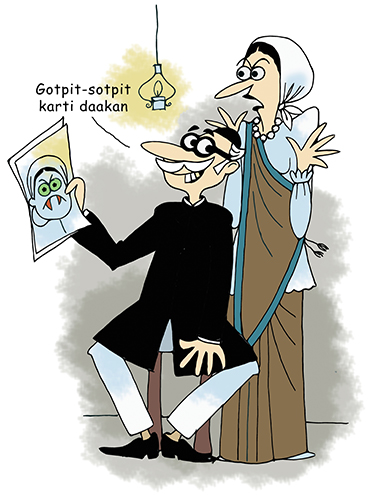The art teacher
Berjis Desai
He walked ramrod straight into the packed classroom. A long black coat, white duckback trousers, black cap and thick black rimmed spectacles. "Salaam (hello), teacher!” the boys greeted him in a singsong fashion.
"Salaam, class!” he reciprocated in a gruff voice. He drew a grotesque figure on the blackboard with a white chalk. Like a cross between ET (Extra Terrestrial) and Taras Bulba (character of a cossack in a romanticized historical novella of the same name). "He is Baluja!” he smiled, revealing his horsey teeth. Class IA, English medium, had a confused look. One podgy fellow on the front bench mustered courage and asked him, "Sir, who is Baluja?” "Behro laagéch (He must be deaf),” he said with irritation, "This fellow I have drawn is Baluja. Now, all of you, careful.”
The podgy fellow’s mother, a schoolteacher, slapped her son for drawing ugly figures in his art book, with BALUJA written prominently. Disbelieving him, she marched to the school, one of the pioneer institutions founded by two Parsis in 1893, and complained bitterly to the old art teacher. "Your son has talent, Madam. He has drawn Baluja very well,” he told the horrified parent. In the weeks which followed, the subjects chosen by this 83-year-old art teacher included daakan, with a sagdi on her head (witch, carrying a fire); bhoot (ghost) with shining, green eyes; and a Parsi ni paidust (a Parsi funeral). It was 1960. Parents seldom complained against schoolteachers. Even if they were old, senile and eccentric. And the art teacher was an institution. He had served the school for 65 years — from 1895, as a lad of 18, with an arts diploma from Navsari, on a monthly salary of six rupees (in 1960, it had increased to Rs 140).

Illustration by Farzana Cooper
Although tall, with handsome features, he could not afford to marry. His salary was exhausted maintaining his widowed mother and a sister who had Down’s syndrome. He could hardly afford the 15 paise BEST bus ticket from Victoria Terminus to Byculla. His only time out was praying twice at his favorite agiary and cooking a spartan vegetarian meal. Sometimes, on an impulse, he visited the newly established (1952) Jehangir Art Gallery.
He could barely speak English. He was at home though in the Gujarati medium of the school. Neither was there much of a problem with the English medium students, as Gujarati happened to be the mother tongue of most – Gujaratis, Bohris, Parsis. He did not have to translate daakan and bhoot and paidust for them. Woe betide the occasional Maharashtrian or South Indian student. In any event, art was a universal language and Baluja was beyond words.
He had taught four generations of several families — great-grandfather, grandfather, father and son — in this all-boys school. He was not an exception. Other Parsi teachers of this school were as quaint and unique. There was this short French teacher who wore a hard white hat like a fire brigade man and consciously aped the mannerisms of Napoleon Bonaparte. The art teacher encouraged his students to draw him — "aagal thi Napoleon né paachhal thi bumbawalo (looks like Napoleon from the front and a fire brigade personnel from the back).” Or his colleague, the math teacher, whose sleeves extended just past his elbow and his trousers ended six inches above his ankle. He would say, "Today, children, we will draw this teacher who wears ardha khamis né pona patloon (half shirts and three-fourths pants).” The art teacher’s favorite was the head clerk of the school, a Gujarati gentleman called Goonga (though rumor traced his paternity to one of the school’s principals), dark complexioned, cherubic with several double chins. Every year, students dutifully had to draw a caricature of "Goongo,” as the art teacher called him, much to Goonga’s consternation.
In his later years, he developed an astute dislike for the color red. "Why does your son insist on coloring every object red?” he asked a puzzled mother whose son had colored a fire brigade truck red.
In his last few years, he formed the habit of suddenly dismissing the class one hour before closing time. Boisterous boys joyously rushed down the staircase and created a ruckus on the pavement, until they were herded back into the school. The art teacher was merrily oblivious of the chaos he had caused.
Although the school did not avail of any government grant, inspection by education inspectors became stringent. Unfortunately for our art teacher, a highly accomplished Parsi spinster visited his classroom. Her mere appearance struck terror in the hearts of most schoolteachers. She was acerbic and did not mince words. Of course, our art teacher was quite amused at the concept of someone, who was like his granddaughter, "inspecting” him. "Salaam, teacher!” chorused the class. "Children! We say good morning, sir!” the inspector caustically observed. He was almost on the verge of tears. He said, "No, no! No good morning, good evening, and all this gotpit sotpit (mumbo jumbo).” The inspector sighed. Her horror intensified when the art teacher’s exotic subjects appeared, one by one, in the children’s art books. She stormed out.
Barging into the principal’s cabin, she said, "This gentleman’s services must be terminated forthwith. Time you say good-bye to him.” The principal mumbled about loyalty and honesty and old traditions. The inspector was adamant. He was paid terminal dues of Rs 3,200.
The art teacher was unable to fathom why he had been sacked after 65 years of long and honest service. He wasn’t too worried about himself. However, he was devastated that the next batch of children would never know about Baluja. No sagdi carrying daakan and no green-eyed ghost would hover around a Parsi ni paidust. And, of course, "Goongo” would go unpainted, for the first time in decades.
Berjis M. Desai is a lawyer in private practice and a part-time writer. He considers himself an unsuccessful community activist.
